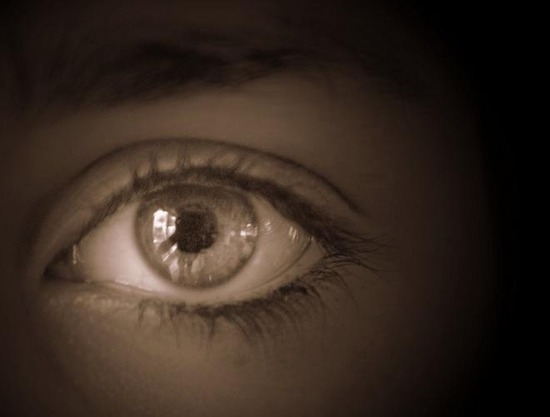【脳の不思議】10の人格を持つ盲目女性、一部の人格において視力が回復!
2015.12.15

11月30日、医学情報サイト「Medical Daily」が報じた内容によると、ドイツ人女性のB・Tさんが視力を失ったのは20歳の時だったという。
B・Tさんは痛ましい事故に遭い、頭部と脳にダメージを被った。そして、病院搬送直後から著しい視力低下が起こり、徐々に何も見えなり、失明した。しかしそれは、脳の外傷や疾患が原因で生じる失明ではなく、「心因性失明」だった。
1998年の調査によれば、心因性失明患者は非常に珍しく、すべての視覚障害者の1%だという。
■少年の人格だった時に視力が回復
しかし13年後、B・Tさんが33歳になったとき、不可思議な出来事が起こった。
彼女は当時、解離性同一性障害(DID=多重人格障害ともいわれる)患者としてドイツ・ミュンヘンのサイコセラピスト、ブリュノ・ウォルトヴォガル博士のクリニックに通院していた。もちろん、彼女は失明していたため、盲導犬を頼りに通っていた。
B・Tさんの症状は「10の人格を持っている」というものだった。各自が名前、性別、年齢、声、性格やジェスチャー、顔の表情に至るまでまったく違う。加えて、ある者は英語のみ、ある者はドイツ語のみ、またある者はバイリンガルと個性豊かだった。
だがある日、B・Tさんはセッション中に突然、傍にあった雑誌の表紙の文字がうっすらと見えることに気づいた。視覚の“スイッチ”が入ったのだ。盲の状態から視覚を取り戻した瞬間、その時の彼女は10代の少年の人格だったという。その後セラピーを重ねるごとに、数文字から数行、やがて明るく映しだされた物体が何か識別できるようになり、最終的には普通に見えるまでに回復していった。
すると驚いたことに、彼女のほかの人格たちも次々と目が見えるようになり、10人のうち8人までが視力を取り戻している。また、視覚刺激に反応するB・Tさんの脳の電気的活動を調べた結果、彼女の視覚野は目が見える人格の時はアクティブになり、盲目の人格の時は非アクティブになることが確認されたのである。
とはいえ、いまだ2人の人格が失明したままだ。これについては、B・TさんのfMRI(機能的磁気共鳴画像法)を調査したことのあるミュンヘンのルートヴィッヒ・マクシミリアン大学のハンス・シュトラスブルガー博士が答えている。
「恐らく、この2名はB・Tさんにとって“避難所”の役割をしていると考えられます。精神的にかなりキツイ状況に陥れば『こんなんだったら、目が見えないほうがマシ!』となることもあるでしょう。そんなとき、見る必要が無くなるよう“スイッチ”を切るんです」
脳科学の分野はいまだにミステリーが多い。B・Tさんにはイザというとき逃げ込める「心の隠れ家」が必要なのだろう。だとしたら、10人中8人まで見えるのだから、無理やりこじ開ける必要もないかもしれない。
(文=佐藤Kay)
参考:「Medical Daily」、「Oddity Central」、「Brain Decoder」ほか
参照元 : TOCANA
Blind Woman with Multiple Personalities Can See When She Is a Teenage Boy
By Sumitra on November 30th, 2015 Category: News
Despite our many technological advancements, the human brain is still a big mystery, as proven by the recently published case of a German woman who, although legally blind, has her sight miraculously restored at times. The 37-year-old suffers from dissociative identity disorder (DID), and apparently has perfect vision when she switches to eight out of her ten personalities.
The woman, only referred to by her initials B.T., first went to see German psychotherapist Dr. Bruno Waldvogel about 14 years ago. She was completely blind at the time and accompanied by a guide dog. She told the doctor that her vision had become severely impaired during an accident at age 20, after which she gradually became blind. Waldvogel checked her medical records, which clearly stated that she had been diagnosed with cortical blindness from trauma to the skull and brain. Her eyes showed no sign of physical damage.
Waldvogel eventually diagnosed B.T. with DID, previously known as Multiple Personality Disorder, which manifested itself through no less than 10 personalities of different names, voices, and genders. Some of her personalities spoke only in German, others used English. But a major breakthrough came after about four years of treatment, when Waldvogel was shocked to witness B.T. recognize a few words on the cover of a magazine. She had assumed the personality of a teenage boy at the time.

Baffled, Waldvogel and his fellow psychologist Dr. Hans Strasburger began to wonder if her blindness was really a physical problem or just a psychological one. So they used an EEG to measure how the visual cortex of her brain responded to visual stimuli. They discovered that when B.T. was ‘blind’, her brain did not respond to the imagery, but when she was in a ‘sighted’ personality state, the measurements were normal. They eventually concluded that the vision problem must have occurred due to an emotional response to the accident, where her body reacted by cutting out what she could see.
“The regaining of vision happened immediately after a therapy session in which a major traumatic event had been worked on,” Dr. Strasburger explained. That was many years after the blindness first began.”
Over time, B.T.’s vision steadily improved – she was able to recognise more words, then brightly lit objects, and eventually everything else around her. Her vision was first limited to just that one personality state, but slowly extended to seven others. According to the doctors, her “sighted and blinded states could alternate within seconds.”

Two of B.T.’s blind personality states still remain, and according to Dr. Strasburger, these might serve as a possibility for retreat. “In situations that are particularly emotionally intense, the patient occasionally feels the wish to become blind, and thus not ‘need to see.’”
参照元 : Oddity Central
Blind Woman With Dissociative Identity Disorder Spontaneously Regains Vision In A Few Of Her 10 Personalities
Nov 30, 2015 04:13 PM

After about four years of therapy, the patient was able to spontaneously read the cover of a magazine during one of her sessions. hans van den berg CC BY 2.0
A blind woman in Germany baffled doctors when she spontaneously regained eyesight in all but two of her 10 personalities. Through therapy, the patient was able to completely regain her sight in the select few and become one of the most fascinating cases of psychogenic blindness in medical history.
The recent report, published in Psych Journal last month, describes the 33-year-old woman, referred to only as B.T., who slowly began losing her eyesight at age 20 after she sustained traumatic head and brain injuries in an accident, Braindecoder reported. By the time B.T. had began seeing a therapist for her dissociative identity disorder, previously referred to as multiple personality disorder, she was completely blind and required the help of a guide dog.
B.T. had a total of 10 personalities, all of which differed by name, voice, reported age and gender, gesture, attitude, facial expressions, personal inclinations, aptitudes, and temperament. In addition, some personalities would only communicate in English, others only German, and some were able to speak both.
After about four years of therapy, B.T. was able to spontaneously read the cover of a magazine during one of her sessions.
"The regaining of vision happened immediately after a therapy session in which a major traumatic event had been worked on. That was many years after the blindness first began," said Dr. Hans Strasburger of Ludwig Maximilian University in Munich, who saw the patient once for an fMRI, Braindecoder reported.
Soon more of her personalities regained the ability to see, and brain scans showed that the spontaneous recovery from blindness was real. Using a tool to measure B.T.’s brain electrical activity in response to visual stimuli, doctors observed that the visual areas of B.T.’s brain remained inactive during her blind personality traits and active in her sighted personalities.
Blindness with no organic origins, such as that exhibited by B.T., is known as psychogenic blindness. According to a 1998 study on non-organic visual loss, psychogenic blindness is rare and believed to account for only 1 percent of all visual problems seen by an ophthalmologist.
Psychogenic blindness is a type of conversion disorder — a physical condition that cannot be explained by physical damage. These conditions are usually caused by an extremely stressful or emotional crisis that will manifest as a physical problem. Other types of conversion disorders include inexplicable paralysis or speech problems.
Scientists are still not completely sure how individuals with this condition are able to switch their conditions on and off, but conversion disorders are usually treated with a combination of counseling and physical therapy. For B.T., therapy allowed her to regain sight in all but two of her 10 personalities.
"These presumably serve as a possibility for retreat," Strasburger told Braindecoder. "In situations that are particularly emotionally intense, the patient occasionally feels the wish to become blind, and thus not 'need to see.'"
Source: Strasburger H, Waldvogel B. Sight and blindness in the same person: Gating in the visual system. Psych Journal. 2015.
参照元 : Medical Daily
解離性同一性障害
解離性同一性障害(かいりせいどういつせいしょうがい、英: Dissociative Identity Disorder ; DID)は、解離性障害のひとつである。かつては多重人格障害(英: Multiple Personality Disorder ; MPD)と呼ばれていた。
解離性障害は本人にとって堪えられない状況を、離人症のようにそれは自分のことではないと感じたり、あるいは解離性健忘などのようにその時期の感情や記憶を切り離して、それを思い出せなくすることで心のダメージを回避しようとすることから引き起こされる障害であるが、解離性同一性障害は、その中でもっとも重く、切り離した感情や記憶が成長して、別の人格となって表に現れるものである。
DSM‒5では、解離性同一症の診断名が併記される。
参照元 : wiki/解離性同一性障害
2015.12.15

11月30日、医学情報サイト「Medical Daily」が報じた内容によると、ドイツ人女性のB・Tさんが視力を失ったのは20歳の時だったという。
B・Tさんは痛ましい事故に遭い、頭部と脳にダメージを被った。そして、病院搬送直後から著しい視力低下が起こり、徐々に何も見えなり、失明した。しかしそれは、脳の外傷や疾患が原因で生じる失明ではなく、「心因性失明」だった。
1998年の調査によれば、心因性失明患者は非常に珍しく、すべての視覚障害者の1%だという。
■少年の人格だった時に視力が回復
しかし13年後、B・Tさんが33歳になったとき、不可思議な出来事が起こった。
彼女は当時、解離性同一性障害(DID=多重人格障害ともいわれる)患者としてドイツ・ミュンヘンのサイコセラピスト、ブリュノ・ウォルトヴォガル博士のクリニックに通院していた。もちろん、彼女は失明していたため、盲導犬を頼りに通っていた。
B・Tさんの症状は「10の人格を持っている」というものだった。各自が名前、性別、年齢、声、性格やジェスチャー、顔の表情に至るまでまったく違う。加えて、ある者は英語のみ、ある者はドイツ語のみ、またある者はバイリンガルと個性豊かだった。
だがある日、B・Tさんはセッション中に突然、傍にあった雑誌の表紙の文字がうっすらと見えることに気づいた。視覚の“スイッチ”が入ったのだ。盲の状態から視覚を取り戻した瞬間、その時の彼女は10代の少年の人格だったという。その後セラピーを重ねるごとに、数文字から数行、やがて明るく映しだされた物体が何か識別できるようになり、最終的には普通に見えるまでに回復していった。
すると驚いたことに、彼女のほかの人格たちも次々と目が見えるようになり、10人のうち8人までが視力を取り戻している。また、視覚刺激に反応するB・Tさんの脳の電気的活動を調べた結果、彼女の視覚野は目が見える人格の時はアクティブになり、盲目の人格の時は非アクティブになることが確認されたのである。
とはいえ、いまだ2人の人格が失明したままだ。これについては、B・TさんのfMRI(機能的磁気共鳴画像法)を調査したことのあるミュンヘンのルートヴィッヒ・マクシミリアン大学のハンス・シュトラスブルガー博士が答えている。
「恐らく、この2名はB・Tさんにとって“避難所”の役割をしていると考えられます。精神的にかなりキツイ状況に陥れば『こんなんだったら、目が見えないほうがマシ!』となることもあるでしょう。そんなとき、見る必要が無くなるよう“スイッチ”を切るんです」
脳科学の分野はいまだにミステリーが多い。B・Tさんにはイザというとき逃げ込める「心の隠れ家」が必要なのだろう。だとしたら、10人中8人まで見えるのだから、無理やりこじ開ける必要もないかもしれない。
(文=佐藤Kay)
参考:「Medical Daily」、「Oddity Central」、「Brain Decoder」ほか
参照元 : TOCANA
Blind Woman with Multiple Personalities Can See When She Is a Teenage Boy
By Sumitra on November 30th, 2015 Category: News
Despite our many technological advancements, the human brain is still a big mystery, as proven by the recently published case of a German woman who, although legally blind, has her sight miraculously restored at times. The 37-year-old suffers from dissociative identity disorder (DID), and apparently has perfect vision when she switches to eight out of her ten personalities.
The woman, only referred to by her initials B.T., first went to see German psychotherapist Dr. Bruno Waldvogel about 14 years ago. She was completely blind at the time and accompanied by a guide dog. She told the doctor that her vision had become severely impaired during an accident at age 20, after which she gradually became blind. Waldvogel checked her medical records, which clearly stated that she had been diagnosed with cortical blindness from trauma to the skull and brain. Her eyes showed no sign of physical damage.
Waldvogel eventually diagnosed B.T. with DID, previously known as Multiple Personality Disorder, which manifested itself through no less than 10 personalities of different names, voices, and genders. Some of her personalities spoke only in German, others used English. But a major breakthrough came after about four years of treatment, when Waldvogel was shocked to witness B.T. recognize a few words on the cover of a magazine. She had assumed the personality of a teenage boy at the time.

Baffled, Waldvogel and his fellow psychologist Dr. Hans Strasburger began to wonder if her blindness was really a physical problem or just a psychological one. So they used an EEG to measure how the visual cortex of her brain responded to visual stimuli. They discovered that when B.T. was ‘blind’, her brain did not respond to the imagery, but when she was in a ‘sighted’ personality state, the measurements were normal. They eventually concluded that the vision problem must have occurred due to an emotional response to the accident, where her body reacted by cutting out what she could see.
“The regaining of vision happened immediately after a therapy session in which a major traumatic event had been worked on,” Dr. Strasburger explained. That was many years after the blindness first began.”
Over time, B.T.’s vision steadily improved – she was able to recognise more words, then brightly lit objects, and eventually everything else around her. Her vision was first limited to just that one personality state, but slowly extended to seven others. According to the doctors, her “sighted and blinded states could alternate within seconds.”

Two of B.T.’s blind personality states still remain, and according to Dr. Strasburger, these might serve as a possibility for retreat. “In situations that are particularly emotionally intense, the patient occasionally feels the wish to become blind, and thus not ‘need to see.’”
参照元 : Oddity Central
Blind Woman With Dissociative Identity Disorder Spontaneously Regains Vision In A Few Of Her 10 Personalities
Nov 30, 2015 04:13 PM

After about four years of therapy, the patient was able to spontaneously read the cover of a magazine during one of her sessions. hans van den berg CC BY 2.0
A blind woman in Germany baffled doctors when she spontaneously regained eyesight in all but two of her 10 personalities. Through therapy, the patient was able to completely regain her sight in the select few and become one of the most fascinating cases of psychogenic blindness in medical history.
The recent report, published in Psych Journal last month, describes the 33-year-old woman, referred to only as B.T., who slowly began losing her eyesight at age 20 after she sustained traumatic head and brain injuries in an accident, Braindecoder reported. By the time B.T. had began seeing a therapist for her dissociative identity disorder, previously referred to as multiple personality disorder, she was completely blind and required the help of a guide dog.
B.T. had a total of 10 personalities, all of which differed by name, voice, reported age and gender, gesture, attitude, facial expressions, personal inclinations, aptitudes, and temperament. In addition, some personalities would only communicate in English, others only German, and some were able to speak both.
After about four years of therapy, B.T. was able to spontaneously read the cover of a magazine during one of her sessions.
"The regaining of vision happened immediately after a therapy session in which a major traumatic event had been worked on. That was many years after the blindness first began," said Dr. Hans Strasburger of Ludwig Maximilian University in Munich, who saw the patient once for an fMRI, Braindecoder reported.
Soon more of her personalities regained the ability to see, and brain scans showed that the spontaneous recovery from blindness was real. Using a tool to measure B.T.’s brain electrical activity in response to visual stimuli, doctors observed that the visual areas of B.T.’s brain remained inactive during her blind personality traits and active in her sighted personalities.
Blindness with no organic origins, such as that exhibited by B.T., is known as psychogenic blindness. According to a 1998 study on non-organic visual loss, psychogenic blindness is rare and believed to account for only 1 percent of all visual problems seen by an ophthalmologist.
Psychogenic blindness is a type of conversion disorder — a physical condition that cannot be explained by physical damage. These conditions are usually caused by an extremely stressful or emotional crisis that will manifest as a physical problem. Other types of conversion disorders include inexplicable paralysis or speech problems.
Scientists are still not completely sure how individuals with this condition are able to switch their conditions on and off, but conversion disorders are usually treated with a combination of counseling and physical therapy. For B.T., therapy allowed her to regain sight in all but two of her 10 personalities.
"These presumably serve as a possibility for retreat," Strasburger told Braindecoder. "In situations that are particularly emotionally intense, the patient occasionally feels the wish to become blind, and thus not 'need to see.'"
Source: Strasburger H, Waldvogel B. Sight and blindness in the same person: Gating in the visual system. Psych Journal. 2015.
参照元 : Medical Daily
解離性同一性障害
解離性同一性障害(かいりせいどういつせいしょうがい、英: Dissociative Identity Disorder ; DID)は、解離性障害のひとつである。かつては多重人格障害(英: Multiple Personality Disorder ; MPD)と呼ばれていた。
解離性障害は本人にとって堪えられない状況を、離人症のようにそれは自分のことではないと感じたり、あるいは解離性健忘などのようにその時期の感情や記憶を切り離して、それを思い出せなくすることで心のダメージを回避しようとすることから引き起こされる障害であるが、解離性同一性障害は、その中でもっとも重く、切り離した感情や記憶が成長して、別の人格となって表に現れるものである。
DSM‒5では、解離性同一症の診断名が併記される。
参照元 : wiki/解離性同一性障害






















